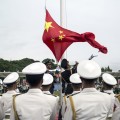As the U.S. Navy sails towards North Korea, the potential for conflict with China also looms.
Two years ago, one of America’s top military leaders, now retired, told this writer that he was “deeply concerned” about the Pentagon’s dependence on China for key computer chips. Concerns also abound about Beijing’s control of the “rare earth” minerals market. These are resources essential for advance weaponry.
The Alliance for American Manufacturing, in a recent report, warns that “America’s military communications systems increasingly rely on network equipment from China, putting our entire defense at risk. A 2012 House intelligence committee investigation, for example, found that the Chinese telecommunications company Huawei, which had been working to expand in the United States, posed a major threat to the U.S. because its equipment could be used to spy on U.S. defense systems and companies. America’s most advanced fighter jets might be blown from the sky by their Chinese-made microchips and Chinese hackers easily could worm their way into the military’s intelligence service…The United States increasingly relies on foreign nations to provide the materials needed for our defense supply chain…Not a single high-tech magnet — crucial to military hardware — is made in America…Defense systems…all face major supply chain vulnerabilities. Take semiconductors, which have been central to U.S. military and economic strength over the past century…the U.S. has faced a steady decline in semiconductor fabrication, which is increasingly happening in Asia. The U.S. share of semiconductor fabrication decreased from nearly 50 percent in 1980 to only 15 percent in 2012.”
In addition to computer chips, resources known as “rare earth” materials are vital to many military components. According to Mining.com, China produces more than 85% of the global supply of the these elements. “China’s policy of consolidating domestic producers and processors while encouraging exports saw the sole US producer of rare earths Molycorp fall into bankruptcy in July last year. While Australia’s Lynas has withered the storm, projects in Greenland, which has the potential to rival China’s biggest production centres, Russia, India and elsewhere have struggled to gain traction amid the low price environment…As a result the US will continue to be beholden to China for more than 90% of its rare earth imports.”
The Congressional Research Service reports that “From the 1960s to the 1980s, the United States was the leader in global rare earth production. Since then, production has shifted almost entirely to China, in part due to lower labor costs and lower environmental standards. Some estimates are that China now produces about 90- 95% of the world’s rare earth oxides and is the majority producer of the world’s two strongest magnets, samarium cobalt (SmCo) and neodymium iron boron (NeFeB) permanent, rare earth magnets…”
In addition to the potential for spying or intentionally disabling U.S. military equipment , threats from defective equipment originating in China looms large. In 2011, Buck Sexton found that, according to U.S. Senate sources, “on 1,800 separate occasions, the U.S. military or contractors have purchased electronics materials for defense systems that were either fake or poorly recycled.In some cases, defective chips made their way into critical U.S. weapons and navigation systems. The examples could provide a serious wake-up call to defense contractors and others involved in the military supply chain…70 percent of them originated in China.Another 20% came from countries like Canada and the U.K. that resold Chinese parts to the U.S. Realistically, closer to 90% of faulty electronics in military equipment came from China…While the report focuses on unintentional threats to the military supply chain, the presence of shoddy Chinese electronics in thousands of devices and the apparent U.S. reliance on China for its national defense supply chain should concern all Americans.”
Frank Vernuccio serves as editor-in-chief of the New York Analysis of Policy and Government at usagovpolicy.com.

















Follow Us